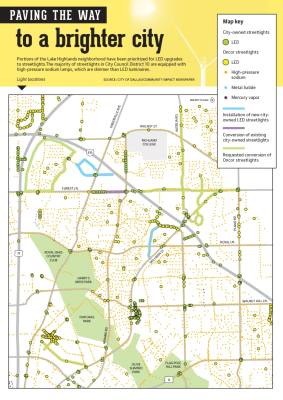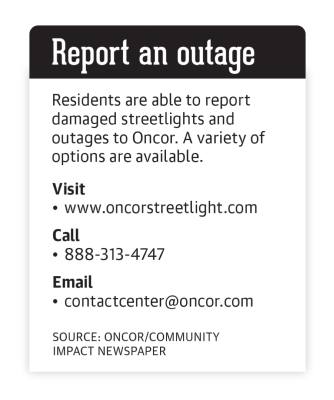The city has requested a total of 297 LED conversions for the Lake Highlands area from Oncor Electric Delivery Company, which owns 72,211 out of the 94,451 streetlights in Dallas, according to city data. The city and the Texas Department of Transportation own the remaining 22,240 streetlights.
LED lights provide brighter illumination and consume less energy than other streetlight varieties, according to Dallas Director of Transportation Ghassan Khankarli. Most other lights in Dallas use dimmer, cheaper lights with high-pressure sodium lamps.
Oncor has already completed upgrades for 30 lights around Whitehurst Drive and Wickersham Road. In addition, the city has completed 157 upgrades around Jupiter and Abrams roads, Forest Lane and the Lake Highlands Town Center.
Dallas has plans to install 55 new LED streetlights around Vantage Point Drive, Marville Drive and Fair Oaks Crossing. In addition, the city has requested 297 LED conversions from Oncor around Hamilton Park and around Audelia Road.
Oncor Communications Manager Kerri Dunn said the electricity provider supports LED lighting, which she said is more efficient than older options. Oncor is discussing future lighting options with city officials.
“Oncor has strived to be a community partner with the city of Dallas for as long as we have provided electric service,” Dunn said in an email. “Streetlights are just one of the many projects or areas of service we have worked with the city on over the years, and we look forward to continuing to work together.”
A brighter future
The city of Dallas is working with Oncor to create a long-term maintenance agreement for more LED streetlights.
Mayor Eric Johnson’s Task Force on Safe Communities identified ample street lighting as a tool to address crime and provide “a sense of safety and well-being,” a 2019 report stated. To that end, annual city budgets for the past two years include $5.5 million for LED upgrades throughout the city, according to a presentation given by Khankarli in a March 29 city of Dallas Transportation and Infrastructure Committee meeting.
Khankarli said work to convert all streetlights is difficult with three entities owning them.
“The conversion to the LED [lights] is a massive, complicated undertaking, especially with the ones that are owned by Oncor,” he said.
Dallas incurs capital costs whenever officials request conversions of fully functioning streetlights to LED, according to Khankarli. Even so, he added that discussions with Oncor have shown a maintenance agreement to convert aging lights to LED could benefit the city.
“You will get longer lifetime hours on the LED, ... and [the] energy utilization is 40%-50% lower,” he said.
Khankarli added Oncor-owned lights could be converted to LED through the proposed agreement within the next five to seven years. That process is still underway, according to Dunn.
“We are engaging in discussions with city officials on future lighting options, but it is too early to confirm specifics on scopes or timelines,” Dunn said.
Council Member Adam McGough echoed the benefits said to come from upgraded streetlights. He said he has been involved in past community efforts to search for faulty streetlights to report to Oncor. Many multifamily communities in City Council District 10 get particularly dark during the summertime, he added.
“We have areas, still, where it’s kind of dangerous because it’s dark, and we have pedestrians mixing with cars,” McGough said. “The more you light it up, the safer it is.”
Dispelling danger
McGough said the mayor’s task force has focused on finding ways to reduce violent crimes through nonpolice efforts. Recent city efforts include when City Council on March 9 approved an investment of $572,000 for roughly 26 new streetlights around Whitehurst Drive.
Those funds come from the Skillman Corridor Tax Increment Financing District, which reinvests a portion of property tax revenues generated from new real estate development, according to the city website.
“There’s been lots of efforts to try to keep our lighting system functioning and working, [with] some more effective than others at different times,” McGough said of streetlight improvements across Dallas. “I think it’s fair to say this is one of the larger efforts around lighting that I’ve certainly been aware of in my 16-plus years working with the city.”
Derrick Battie, community liaison for South Oak Cliff High School, worked as the head of security at the school for 15 years. Battie also served on the mayor’s task force.
He said brighter streetlights assist in “blight remediation,” or exposing crime by illuminating traditionally dim regions of the city. Battie added the mayor’s task force identified streetlights that have not been replaced by Oncor for about 40 years.
“We need solutions. That means we’re going to take these lights down, and we’re going to put these lights up,” Battie said. “We get back into blight remediation: How do you go in and take a spot where maybe drug dealers and gang members meet comfortably in the dark?”
Brian Martinez, public information officer with the Dallas Police Department, said brighter lighting boosts public awareness of crime and visibility for drivers to see pedestrians.
“Improved lighting plays a big role in public safety,” Martinez said. “Not only does it keep potential offenders away, but new lighting can encourage residents to spend more time in their front yards and thus increase informal surveillance.”
State aid
The state is also working to upgrade streetlights with LED luminaires, TxDOT Public Information Officer Tony Hartzel said.
“LEDs are more efficient than the typical high-pressure sodium luminaire heads,” Hartzel said in an email. “They are more cost effective as they use less power and have a longer life span.”
Just over 11% of the 6,889 streetlights that TxDOT owns in Dallas are equipped with LED luminaires, according to the city.
Hartzel said although TxDOT owns streetlights, Dallas has “varying degrees of maintenance responsibility.” TxDOT reimburses all maintenance costs for streetlights at major interchanges and highway entrance and exit ramp locations, Hartzel said.
For longer sections of roadway, TxDOT pays half of power and maintenance costs.
Supply chain shortages and delays related to the COVID-19 pandemic are also impeding upgrades, Hartzel added. But he said TxDOT will develop upgrade plans once the light inventory in Dallas has been finalized and submitted to the state.
“We have begun coordination with the city on upgrades to LEDs on state-owned equipment,” Hartzel said. “TxDOT will either reimburse them for the work, or TxDOT will do it with our in-house contract depending on the circumstances.”
The process of making Dallas streets brighter will continue for months to come, according to Khankarli. Looking ahead, he said his team is discussing streetlight standards with private developers. The department is also working to update its street design manual this spring.
“I think the [benefit] is there,” he said. “We need to continue doing it.”
Alexander Willis contributed to this report.









